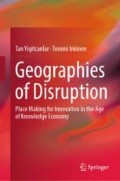Abstract
As much as having an in-depth understanding on the conceptual aspects of innovative geographies, it is also important to have empirical evidence on how these geographies are formed or being formed. This part of the book focuses on practical examples from the Nordic context identifying the most well-known and successful urban locations that may be deemed as forerunners in smart development. Nordic countries and Estonia are easily selectable locations as they all have gained interest as highly adopting ICT countries. All the other cities are from the Nordic countries except the Baltic state of Estonia. The chapter provides an introduction to this part of the book that searches for empirical evidence from the practice.
Access this chapter
Tax calculation will be finalised at checkout
Purchases are for personal use only
References
Eurostat. (2018). Database. Available at https://ec.europa.eu/eurostat/data/database.
Lichtenthaler, U., & Ernst, H. (2008). Innovation intermediaries: Why Internet marketplaces for technology have not yet met the expectations. Creativity and Innovation Management, 17, 14–25.
Salles-Filho, S., Bonacelli, M. B., Carneiro, A. M., Castro, P. D., & Santos, F. O. (2011). Evaluation of ST&I Programs: A methodological approach to the Brazilian small business program and some comparisons with the SBIR program. Research Evaluation, 20, 159–171.
Suorsa, K. (2007). Regionality, innovation policy and peripheral regions in Finland, Sweden and Norway. Fennia, 185(1), 15–29.
Yigitcanlar, T., & Lönnqvist, A. (2013). Benchmarking knowledge-based urban development performance: Results from the international comparison of Helsinki. Cities, 31(1), 357–369.
Yigitcanlar, T., Inkinen, T., & Makkonen, T. (2015). Does size matter? Knowledge-based development of second-order city-regions in Finland. disP-The Planning Review, 51(3), 62–77.
Author information
Authors and Affiliations
Corresponding author
Rights and permissions
Copyright information
© 2019 Springer Nature Switzerland AG
About this chapter
Cite this chapter
Yigitcanlar, T., Inkinen, T. (2019). Introduction to Part II. In: Geographies of Disruption. Springer, Cham. https://doi.org/10.1007/978-3-030-03207-4_6
Download citation
DOI: https://doi.org/10.1007/978-3-030-03207-4_6
Published:
Publisher Name: Springer, Cham
Print ISBN: 978-3-030-03206-7
Online ISBN: 978-3-030-03207-4
eBook Packages: Social SciencesSocial Sciences (R0)

